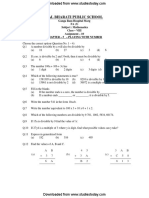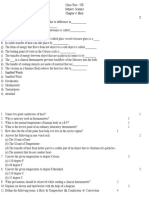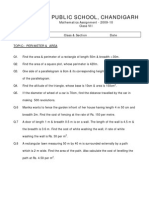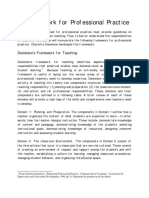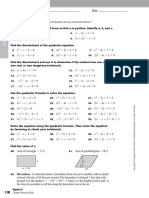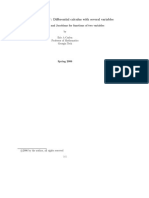Quadrilaterals and Their Properties: Individual Pathways
Quadrilaterals and Their Properties: Individual Pathways
Uploaded by
StanleyCopyright:
Available Formats
Quadrilaterals and Their Properties: Individual Pathways
Quadrilaterals and Their Properties: Individual Pathways
Uploaded by
StanleyOriginal Description:
Original Title
Copyright
Available Formats
Share this document
Did you find this document useful?
Is this content inappropriate?
Copyright:
Available Formats
Quadrilaterals and Their Properties: Individual Pathways
Quadrilaterals and Their Properties: Individual Pathways
Uploaded by
StanleyCopyright:
Available Formats
measurement anD Geometry geometriC reasoning
eXerCise
5e Quadrilaterals and their properties
individual FluenCY
PatHWays
1 We15 Name the following quadrilaterals, giving reasons for your answers.
eBoo
eBookk plus
a b c
Activity 5-E-1
Quadrilaterals
doc-1749
Activity 5-E-2
More quadrilaterals
doc-1750
Activity 5-E-3
Advanced
quadrilaterals
d e f
doc-1751
2 mC a This quadrilateral is a:
A square
B rectangle
C kite
D parallelogram
e rhombus
b This quadrilateral is a:
A trapezium
B parallelogram
C rhombus
D kite
e square
c This quadrilateral is a:
A trapezium
B square
C kite
D rhombus
e parallelogram
3 We16 Find the value of the pronumeral in each of the following diagrams.
a t 42 b
115
110
42 138
b 50
c d 18
120
t 20
162 maths Quest 7 for the australian Curriculum
measurement anD Geometry geometriC reasoning
e f
54
107 107
m
p
g 127 h 32
250 c
12
s
i
k
110
93
4 We17 Find the value of the pronumeral in each of the following diagrams, giving reasons for
your answers.
a m b c
75
132 t
78
d e 63 f 73
108
z
f p
5 We18 Find the value of the pronumerals in each of the following diagrams.
a b c
98 d c
m m t
c t
82
64
36
Chapter 5 Geometry 163
measurement anD Geometry geometriC reasoning
d e f n
106 75 115
96 p x m p
91
m
t
6 mC The value of t in the diagram at right is: t
A 360 B 112
C 222 D 138
42
e 180
7 mC The value of r in the diagram at right is:
117
A 117 B 180
C 234 D 126
e 63
r
understanding
8 State whether each of the following statements is true or false.
a All squares are rectangles.
b All squares are rhombuses.
c All rectangles are squares.
d Any rhombus with at least one right angle is a square.
e A rectangle is a parallelogram with at least one angle equal to 90.
9 mC A rectangle is a quadrilateral because:
A it has 4 right angles B it has 2 pairs of parallel sides
C its opposite sides are equal in length D it has 4 straight sides
e it has 2 pairs of parallel sides and 4 right angles
10 Draw 4 equilateral triangles with side lengths 4 cm and cut them out.
a Use 2 of these triangles to make a rhombus. Draw your solution.
b Use 3 of these triangles to make a trapezium. Draw your solution.
c Use all 4 triangles to make a parallelogram.
Draw your solution.
11 Copy and cut out the set of shapes shown at right.
Arrange the shapes to form a square. Draw your solution.
12 In your house, find an example of each type
of quadrilateral discussed in this section.
Write down the type of quadrilateral and
where you found it.
In the following questions, remember to provide coded
reasons for any relationships you form.
13 This photograph shows the roof of a fast food restaurant.
119
Calculate the value of p.
p
164 maths Quest 7 for the australian Curriculum
measurement anD Geometry geometriC reasoning
14 Find the size of the obtuse angle in the kite shown at right.
15 Two angles in a parallelogram are 45 and
135. Find the other 2 angles.
16 Tom measures 2 angles of a kite at 60
and 110, but forgets which angle is which.
Draw 3 different kites that Tom may have
measured, showing the size of all angles in
each diagram.
17 Below are sets of 4 angles. For each of the sets decide 65
65
whether it is possible to construct a quadrilateral.
Explain your answer.
a 25, 95, 140, 100 b 40, 80, 99, 51
18 Three angles of a quadrilateral are 60, 70 and 100.
a What is the size of the fourth angle of this quadrilateral?
b How many quadrilaterals with this set of angles are possible?
c Construct one quadrilateral with the given angle sizes in your book. (The choice of the
length of the sides is yours.)
reasoning
19 Val and Peter want to replace their front gate with another of the same design. To have this gate
made, they need to supply a diagram of it with all measurements and angles shown. Study the
photograph of Val and Peters gate and use it to help you answer the questions below.
8 cm
27 18 cm
60 cm
1m
a There are 4 different shapes formed by the metal bars of the gate. How many different
types of triangles are there? Can you name them?
b How many types of quadrilaterals are there? Name them.
c Draw a diagram of the gate showing the length measurements and the one angle that is
given.
d Use this angle to calculate all the remaining angles in the diagram.
e Using a ruler and protractor, design a fence that is to be constructed using metal bars.
Include different triangles and quadrilaterals to
make your design as interesting as possible. reFleCtion
Write a short report describing the shapes What would be an easy way to
you have used and important angles which remember the sum of angles in
need to be marked on your design to assist quadrilaterals?
in the construction of the fence.
Chapter 5 Geometry 165
You might also like
- Holt Algebra 1 - Chapter 11 - Standardized TestDocument8 pagesHolt Algebra 1 - Chapter 11 - Standardized TestStanleyNo ratings yet
- 1-3 Practice - ADocument3 pages1-3 Practice - AStanleyNo ratings yet
- Visto Home Test - 2 - Class 6Document10 pagesVisto Home Test - 2 - Class 6GAJALAKSHMI LNo ratings yet
- 1-6 Practice - BDocument2 pages1-6 Practice - BStanleyNo ratings yet
- I. Give A Syllogism That Manifest A Real-Life Scenario. Explain The Truthfulness of Your Major Premise. Write Your Answers On The Space ProvidedDocument4 pagesI. Give A Syllogism That Manifest A Real-Life Scenario. Explain The Truthfulness of Your Major Premise. Write Your Answers On The Space ProvidedZhaina GenoveNo ratings yet
- Class-5, Maths, PT-3, Revision WorksheetDocument2 pagesClass-5, Maths, PT-3, Revision WorksheetRashi BakshNo ratings yet
- Algebra: Class VI. BPS Maths WorksheetDocument2 pagesAlgebra: Class VI. BPS Maths Worksheetfgh ijkNo ratings yet
- 10 Mathematics Area Related To Circle Test 05Document2 pages10 Mathematics Area Related To Circle Test 05Enrique AjeetNo ratings yet
- CL 5 MathsDocument9 pagesCL 5 MathsRajkumarNo ratings yet
- Maths Sample Paper For Class 11 Paper 1Document16 pagesMaths Sample Paper For Class 11 Paper 1Deepak GiriNo ratings yet
- Class 7 Decimals Worksheet 1Document3 pagesClass 7 Decimals Worksheet 1SAHASRANo ratings yet
- ICSE Class 6 Physics Important QuestionsDocument3 pagesICSE Class 6 Physics Important Questionsnandasankhadeep20No ratings yet
- Subject:: Swami Sant Dass Public School Fi-Rst Periodic TEST (2020-21) Class-Viii Mathematics - TIME: 1 Hrs. M.M.: 50Document4 pagesSubject:: Swami Sant Dass Public School Fi-Rst Periodic TEST (2020-21) Class-Viii Mathematics - TIME: 1 Hrs. M.M.: 50GSSS udhopur barsalNo ratings yet
- Cls 8 Direct2Document4 pagesCls 8 Direct2Galistus GamingNo ratings yet
- CBSE Class 7 Maths WorksheetDocument5 pagesCBSE Class 7 Maths WorksheetsonaliforcsNo ratings yet
- Maths Class7 - Assignment-1Document2 pagesMaths Class7 - Assignment-1sanqcNo ratings yet
- 10 Math Worksheet CH-6 TrianglesDocument4 pages10 Math Worksheet CH-6 TrianglesGanesaperumalNo ratings yet
- How Many Squares Grade 5Document4 pagesHow Many Squares Grade 5Greeshma ReddyNo ratings yet
- RD Sharma Class 8 Chapter 6 Alzebraic Expressions and IdentitiesDocument57 pagesRD Sharma Class 8 Chapter 6 Alzebraic Expressions and IdentitiesJilay shahNo ratings yet
- CBSE Clas 7 Maths Worksheet - Exponents & Powers PDFDocument4 pagesCBSE Clas 7 Maths Worksheet - Exponents & Powers PDFIhtesham HussainNo ratings yet
- V MathsDocument8 pagesV MathsSuresh GurjarNo ratings yet
- Complex Numbers Class XIDocument6 pagesComplex Numbers Class XIUdyamGNo ratings yet
- Class 8 Algebraic Identities: Answer The QuestionsDocument3 pagesClass 8 Algebraic Identities: Answer The Questionsshyam0% (1)
- Class-8 Maths Linear Equations Worksheet-2Document1 pageClass-8 Maths Linear Equations Worksheet-2p.s.22022010No ratings yet
- Class 3 Worksheet 2.6.2 - Roman NumbersDocument2 pagesClass 3 Worksheet 2.6.2 - Roman NumbersSumaira KhanNo ratings yet
- Assignment of Rational Numbers Class Viii (4) - 83114 - dpsbsr312Document1 pageAssignment of Rational Numbers Class Viii (4) - 83114 - dpsbsr312Vinay KumarNo ratings yet
- Grade 5 HCF and LCMDocument15 pagesGrade 5 HCF and LCMneelu33No ratings yet
- Class 7 PhysicsDocument2 pagesClass 7 PhysicsSubhajit Bakshi100% (1)
- West Bengal Board Class 9 Physical Science and Environment SyllabusDocument3 pagesWest Bengal Board Class 9 Physical Science and Environment SyllabusRadhika RajNo ratings yet
- Class 8 Simple Interest: Answer The QuestionsDocument2 pagesClass 8 Simple Interest: Answer The QuestionsRaajendra JadhavNo ratings yet
- % Class 5Document9 pages% Class 5Vaishali GargNo ratings yet
- Unit Test 1 Math Class X PDFDocument4 pagesUnit Test 1 Math Class X PDFPoornachandra YaladaluNo ratings yet
- 6th Class Maths MCQsDocument4 pages6th Class Maths MCQsHassaan Ahmed SajidNo ratings yet
- COMMON PERIODIC TEST - 1 (2020-2021) MathematicsDocument10 pagesCOMMON PERIODIC TEST - 1 (2020-2021) Mathematicssan abhinavNo ratings yet
- Grade 7 Lines and Angles inDocument16 pagesGrade 7 Lines and Angles inSourav bhattacharyyaNo ratings yet
- CBSE Class 8 Mathematics Worksheet - Playing With NumbersDocument6 pagesCBSE Class 8 Mathematics Worksheet - Playing With NumbersAnoop Sahu100% (1)
- Playing With NumbersDocument1 pagePlaying With NumbersAnoop SahuNo ratings yet
- Summer Holiday Assignment 2023Document4 pagesSummer Holiday Assignment 2023Yung GeeNo ratings yet
- Maths Class 6 Annual-2Document4 pagesMaths Class 6 Annual-2Satpreet DhanjalNo ratings yet
- QP Math Final Exam ViiDocument2 pagesQP Math Final Exam ViiMatrix Hindustani GamerNo ratings yet
- 6th Techno Work Sheet - 6Document2 pages6th Techno Work Sheet - 6shreyasNo ratings yet
- Class VII Science Chapter Heat WorksheetDocument2 pagesClass VII Science Chapter Heat Worksheetchandramani.goswamiNo ratings yet
- First Terminal Examination-2014 Environmental Studies Time: 3 Hrs. Class - V M.M.: 100Document4 pagesFirst Terminal Examination-2014 Environmental Studies Time: 3 Hrs. Class - V M.M.: 100Seenu S100% (1)
- Math 7 Review Practice TestDocument30 pagesMath 7 Review Practice Testjtwt64100% (1)
- MCQ Class ViiDocument3 pagesMCQ Class ViiGAYATHRI MNo ratings yet
- Second Quarter Periodical Test Reviewer Math IiiDocument5 pagesSecond Quarter Periodical Test Reviewer Math IiiLeslie OprenarioNo ratings yet
- Revision Class6 2023Document14 pagesRevision Class6 2023Utkarsh RazdanNo ratings yet
- Class 6 Algebra Work Sheet-1Document2 pagesClass 6 Algebra Work Sheet-1shafeeqm3086No ratings yet
- Class 4 Maths WsDocument3 pagesClass 4 Maths WsAkansha SinghNo ratings yet
- Class 6 MathsDocument2 pagesClass 6 Mathsfgh ijkNo ratings yet
- (Worksheet) Algebraic Expression PDFDocument17 pages(Worksheet) Algebraic Expression PDFtanaeb5170No ratings yet
- Grade 4 Geometric Measurement WBDocument18 pagesGrade 4 Geometric Measurement WBpreetiNo ratings yet
- Maths Class 3 Mid TermDocument2 pagesMaths Class 3 Mid TermbeakraamNo ratings yet
- The Snail English Grade 6Document8 pagesThe Snail English Grade 6surabhiNo ratings yet
- Class 7 Exponents WorksheetDocument3 pagesClass 7 Exponents WorksheetAayushNo ratings yet
- Class 6 Understanding Elementary Shapes NotesDocument25 pagesClass 6 Understanding Elementary Shapes NotesFARIDA AZIZANo ratings yet
- 8th MCQ Parallelograms and QuadrilateralsDocument2 pages8th MCQ Parallelograms and QuadrilateralsMorgan ThomasNo ratings yet
- Class VII-Maths-Area and PerimeterDocument1 pageClass VII-Maths-Area and Perimetermona_1327No ratings yet
- Math Question Paper Sept 2023Document9 pagesMath Question Paper Sept 2023biplabNo ratings yet
- VI - VIII Summer Assignment 2016-17Document10 pagesVI - VIII Summer Assignment 2016-17bhbhbsgjdfg0% (1)
- Mount Litera Zee School, GZB Half Yearly Examination (2021-22) Subject: Mathematics Max - Marks:80 Grade: IDocument6 pagesMount Litera Zee School, GZB Half Yearly Examination (2021-22) Subject: Mathematics Max - Marks:80 Grade: IAayush UpadhyayNo ratings yet
- Maths PDFDocument4 pagesMaths PDFrthirupaNo ratings yet
- Exercise 5 DDocument6 pagesExercise 5 DStanleyNo ratings yet
- Rationalworksheets1-15 1Document17 pagesRationalworksheets1-15 1troy0% (1)
- Math 10 Curriculum MapDocument4 pagesMath 10 Curriculum MapStanley0% (1)
- 1-5 Practice - CDocument2 pages1-5 Practice - CStanleyNo ratings yet
- Charlotte Danielson's Framework For Professional Practice Web PDFDocument5 pagesCharlotte Danielson's Framework For Professional Practice Web PDFStanley100% (2)
- WCCSB JD Mathematics Teacher of Junior HighDocument5 pagesWCCSB JD Mathematics Teacher of Junior HighStanleyNo ratings yet
- Curr Map Template 2Document2 pagesCurr Map Template 2StanleyNo ratings yet
- Practice A: Name - DateDocument3 pagesPractice A: Name - DateStanleyNo ratings yet
- 2-1 Practice - ADocument2 pages2-1 Practice - AStanley0% (1)
- 1-8 Practice - CDocument2 pages1-8 Practice - CStanleyNo ratings yet
- 2-1 Practice - BDocument2 pages2-1 Practice - BStanley50% (2)
- 1-9 Practice - ADocument4 pages1-9 Practice - AStanley0% (1)
- 1-8 Practice - BDocument2 pages1-8 Practice - BStanleyNo ratings yet
- 1-8 Practice - ADocument2 pages1-8 Practice - AStanleyNo ratings yet
- 1-7 Practice - BDocument2 pages1-7 Practice - BStanley0% (1)
- 1-2 Practice - ADocument4 pages1-2 Practice - AStanleyNo ratings yet
- 1-4 Practice - ADocument2 pages1-4 Practice - AStanleyNo ratings yet
- 1-7 Practice - ADocument3 pages1-7 Practice - AStanleyNo ratings yet
- 1-1 Practice - ADocument3 pages1-1 Practice - AStanleyNo ratings yet
- SAT/ACT Chapter Test: Name - DateDocument3 pagesSAT/ACT Chapter Test: Name - DateStanleyNo ratings yet
- Holt Algebra 1 - Chapter 11 - Quiz 2Document2 pagesHolt Algebra 1 - Chapter 11 - Quiz 2StanleyNo ratings yet
- Maths November 2022 Question PaperDocument6 pagesMaths November 2022 Question PaperKumar SubramanianNo ratings yet
- Lecture 4 - Kamal - Static Force AnalysisDocument11 pagesLecture 4 - Kamal - Static Force AnalysisOmar Mohammed IbrahimNo ratings yet
- N-Q.1, N Q.3, A-Ced.1, A-Rei.4, F-If.2, F-BF.2, F Le.2, G-SRT.8Document20 pagesN-Q.1, N Q.3, A-Ced.1, A-Rei.4, F-If.2, F-BF.2, F Le.2, G-SRT.8mrsmassieNo ratings yet
- Biomechancal Principles in Orthodontics / Orthodontic Courses by Indian Dental AcademyDocument84 pagesBiomechancal Principles in Orthodontics / Orthodontic Courses by Indian Dental Academyindian dental academy100% (1)
- G8 Extrior Angle Inequality TheoremDocument8 pagesG8 Extrior Angle Inequality TheoremTracy Lloyd MaaghopNo ratings yet
- January Gold AnswersDocument31 pagesJanuary Gold AnswersNagajyothi KodaliNo ratings yet
- Keith Conrad: N 0 N N 1 NDocument13 pagesKeith Conrad: N 0 N N 1 NdogbitesmanNo ratings yet
- 637Document8 pages637Bhavsar HardikNo ratings yet
- AEMx CH15Document56 pagesAEMx CH15林茂泉No ratings yet
- DLP Finding Volume of Cube and Rectangular PrismDocument10 pagesDLP Finding Volume of Cube and Rectangular PrismDom MartinezNo ratings yet
- Lines Angles and TrianglesDocument7 pagesLines Angles and Trianglesprinkit patelNo ratings yet
- Chapter 1 of Calculus++ - Differential Calculus With Several VariablesDocument127 pagesChapter 1 of Calculus++ - Differential Calculus With Several VariablesNebil YisuNo ratings yet
- Cee235b Handout JacobianDocument4 pagesCee235b Handout JacobianNguyen DuyNo ratings yet
- KTU 2018-22 Calculus Question Paper PDFDocument3 pagesKTU 2018-22 Calculus Question Paper PDFsunNo ratings yet
- Boris Stankovi C, Ervin Maci C, Haris Imamovi CDocument7 pagesBoris Stankovi C, Ervin Maci C, Haris Imamovi CKinG AleXNo ratings yet
- CalculusDocument166 pagesCalculusCris SosaNo ratings yet
- Sup 2aDocument3 pagesSup 2aSamNo ratings yet
- German English Mat 00 Hym ADocument140 pagesGerman English Mat 00 Hym AOsho Arun LoveNo ratings yet
- q2 Math NotesDocument3 pagesq2 Math NotesFranz Gabriel GuevarraNo ratings yet
- Born Approximately 624 BC, Miletus, Asia Minor. (Now Balat, Turkey) Died Approximately 547 BCDocument3 pagesBorn Approximately 624 BC, Miletus, Asia Minor. (Now Balat, Turkey) Died Approximately 547 BCAimThon Sadang GonzalesNo ratings yet
- F.E. (Semester - I) Examination, 2011 (2008 Pattern) Engineering Graphics - IDocument8 pagesF.E. (Semester - I) Examination, 2011 (2008 Pattern) Engineering Graphics - IPratik WalimbeNo ratings yet
- H. Ord T. ENG. (CEI), MI. PLANT E., FIED., ARAeS., CERT. ED. (Auth.) - General Engineering Drawing Examples (1973, Macmillan Education UK)Document64 pagesH. Ord T. ENG. (CEI), MI. PLANT E., FIED., ARAeS., CERT. ED. (Auth.) - General Engineering Drawing Examples (1973, Macmillan Education UK)Giovanni MedranoNo ratings yet
- Kinematic Analysis NotesDocument5 pagesKinematic Analysis NotesS Hashim RizviNo ratings yet
- Vector ExamplesDocument7 pagesVector Examplesanon1992No ratings yet
- Ternary Phase DiagramsDocument10 pagesTernary Phase Diagramskikiomen4No ratings yet
- Math ProblemsDocument10 pagesMath ProblemsACHIENG REBECCANo ratings yet
- Notes For The Course General Relativity V 2.4: Luca AmendolaDocument109 pagesNotes For The Course General Relativity V 2.4: Luca AmendolaJosepNo ratings yet
- Igcse Maths QuestionsDocument87 pagesIgcse Maths QuestionscarlotaNo ratings yet
- Class 7 - IMO 2 PDFDocument5 pagesClass 7 - IMO 2 PDFChadwick TgrNo ratings yet




































